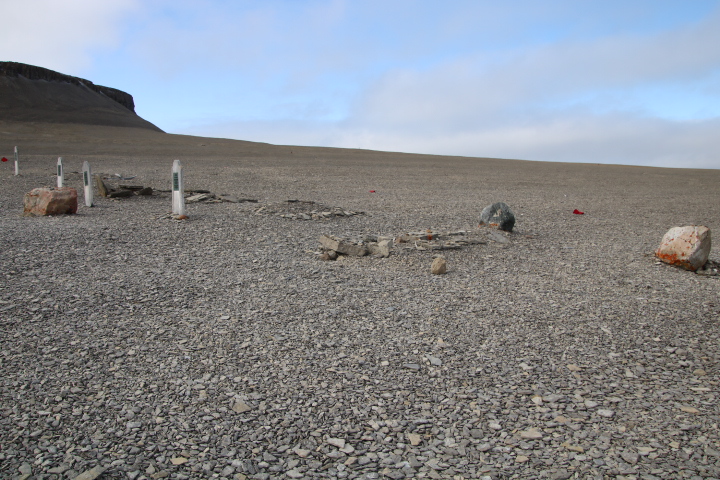At breakfast we had reached 74N 90W with an overcast sky passing fog, a moderate chop and some snow showers. By 13:00 we were dressed for our landing, just as our title page states, “This is how a (couple) must dress to step outside” – at least 5 layers, over trousers and good strong boots. It cannot be done in a few minutes!





Beechey Island takes its name from Captain Frederick Beechey, who in 1825 – 28 searched for the NWP from the Bering Strait and is thought to have reached the then unnamed island.
After Parry’s voyages in the north the Admiralty thought it was good to name the unnamed islands, straits and headlands after British sailors, but only if they had enough names!



The island which has been created by wave action destroying an isthmus is the home to the graves of three members of Franklin’s 1845 expedition.


They are Able Seaman John Hartnell,

Marine Private William Braine, also from the Erebus

and Stoker John Torrington of the Terror, all of whom had died in the winter of 1845 -6.

On the headboard of Torrington’s grave is a sentence that noted that he died on 1st January 1846 on board the Terror which may indicated that the ships may not have been wrecked here as many supposed.
Nearby many more items were found including rope, timber, sail, brass and more than 600 preserved meat and soup cans that had been emptied and filled with pebbles.


There is still debate amongst historians as to what happened here. A fourth body is interred here, Thomas Morgan, who was a member of a search party for Franklin in 1854.

The original headstones are preserved in the National Museum in Ottawa. They were replaced with fibreglass replicas which were destroyed by the weather and today are made of substantial oak and brass.


The new archaeology is helping to explain a contentious theory that related to lead poisoning of members of both ships. Beattie and Geiger, in “Frozen in Time”, describe their exhumation of the three bodies on Beechey Island in the 1980s. This showed that the men were suffering from scurvy (which was not unusual on long voyages), but what was unusual was the lead found in bones and tissue. They suggested that the supplies of preserved food in cans had been contaminated by the lead washed out of the solder by the salt preserving the contents. Nearby was a cairn made from 600 -700 gravel filled cans which may indicate that Franklin knew the problem and disposed of these to inform people who came later. The evidence from 2016, however, concludes that lead poisoning takes a lifetime of permeation but a quicker way is by infiltrating the body with a continuous ‘drip’ of lead. The state of the art desalination plants supplied both ships through lead pipes with hot and cold water, regularly consumed and used in a way that would introduce high levels into the body quickly.
Additionally, there has been some evidence from bones and skeletons of butchery and the use of European knives to remove flesh from bones as well as ‘pot polish’ in cooking pans used for boiling meat. Work is still going on using skull and facial reconstruction to match photographs with the evidence. For example, the ship’s doctor Goodsir, has been accurately matched to remains and a photograph.
From the upper deck of the ship it can be seen that the bay has been created by wave action upon an esker that originally linked the island with Devon island. During dinner we moved towards the next port of call along Lancaster Sound and all engines were stopped when a polar bear was sighted
Other vessels, since Franklin’s, have been trapped in the ice and their crews survived. Historians are beginning to consider that if explorers reached an area that potential rescuers did not have any knowledge of, or was assumed to be inaccessible, then it was considered “all was lost”. This seems to support Cook’s 18th century fake findings and speculations. Scientists have estimated that during the Franklin period, the Peel Sound, (that we avoided that today) would be only open one year in five, which seems to follow our experience as we did not make it in 2018. It was Franklin’s misfortune that he reached this “Arctic Labyrinth” (Williams G. 2010). So, it is thought that, the real tragedy of the Franklin expedition is that there were likely to have been survivors when searches were launched, but they had been sent in the wrong direction. There are still so many unexplained questions.